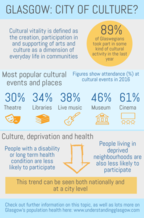Overview
Cultural Vitality is defined as the creation, participation in and supporting of arts and culture as a dimension of everyday life in communities.
It has three components:
- Presence – of opportunities for cultural participation
- Participation – in arts and culture, either through direct participation in activities or attendance as a consumer
- Support – resources required to bring opportunities for arts and cultural participation to fruition and to sustain or expand them
Click on our infographic to see the key facts from this indicator set. 
Summary
(Data mainly from Scottish Household Survey, 2016)
- 89% of Glaswegians took part in some kind of cultural activity in the past 12 months (2016).
- Reading for pleasure is the most common cultural activity of Glaswegians - 62% of adults read for pleasure, while 22% used a computer/social media for creative work and 13% took part in crafts such as knitting or pottery (2016).
- Only 46% of Glaswegians with no qualifications had taken part in a cultural activity in the last year. Those with long term illnesses or disabilities were also much less likely to participate in cultural activities (2016).
- The most attended cultural events or cultural places visited among Glaswegians were: cinema (61%), museums (46%), live music events (38%), libraries (34%) and theatre (30%).
- Glasgow is home to 41% of Scotland’s actors, dancers, broadcasters, 38% of its musicians and 29% of its artists and graphic designers (Glasgow Cultural Statistics Digest, 2010).
This section also highlights participation in sporting activities. A brief summary of sports activities is provided below. (Data from Scottish Household Survey, 2016)
- Walking is by far the most popular physical activity of Glaswegians; swimming, keep fit/aerobics, running, dancing, football and weight training are also relatively common.
- Younger adults tend to be involved in the greatest range of different activities whilst middle aged and older adults are far more likely to walk for recreational purposes rather than take part in other activities.
- Around 27% of Glaswegians did not participate in any sporting activity over a 4 week period.
The data on the Understanding Glasgow website comes from a variety of administrative sources and surveys, and the frequency of updates to these sources varies. The graphs and text on each page should indicate the period to which an indicator refers. In some cases, where more recently published data is not available, we still use older published sources, such as the 2011 Census. Find out more about the timeliness of data presented on this website.
Note
The Scottish Government have published a new report which looks at the impact of cultural engagement and sports participation on health and satisfaction with life in Scotland. Click here to access the Healthy Attendance? report.
Additional Resources
-
ResourceFriday, 25 March 2011
Monitoring Glasgow 1990
A report following Glasgow's year as European City of Culture, by John Myerscough -
ResourceFriday, 25 March 2011
Making the Most of Glasgow's Cultural Assets
A 1991 report by Comedia for the Glasgow Development agency -
ResourceMonday, 7 March 2011
The Myerscough Report
A digest of Glasgow's cultural statistics -
ResourceWednesday, 19 August 2009
A Games Legacy for Glasgow
Brochure outlining the potential legacy of Glasgow's role as Commonwealth Games host city in 2014.






